Top Ten Retail Trends that Will Change the Way We Shop in 2014
As the U.S. economy continues to improve, it appears that a stronger job market and increased home values finally have consumers spending again. But make no mistake, today’s shopper is not the same over-spending drunken sailor that ran up credit card debt at the malls back in 2008. More than 70 percent of today’s shoppers still feel like they’re in a recession and are shopping less than they did five years ago, according to a recent Nielsen study.
Changes to the consumer psyche aren’t the only things changing the way we purchase things. Technological advances and evolving expectations are also transforming the shopping experience.
Here are 10 trends that will change the way you shop in 2014 (and beyond):
1. Big data will determine prices. Like all industries, retail is turning to big data to find ways to maximize profits, which often means instituting dynamic pricing models both online and in-store. Retailers have always increased prices during times of high demand and slashed them when traffic is weaker, but today’s data allows them to do this in a much more relevant and real-time manner. In addition to shifting prices based on demand, retailers will use geo-targeting and other technology to maximize prices based on both geographic and consumer-purchasing history.
2. Mobile purchasing hits the mainstream. E-commerce has been growing for years, but now consumers are shifting away from purchasing items from their desktop or laptop to buying via their phone or tablet. In 2013, mobile shopping accounted for 17 percent of Cyber Monday shopping, a 55 percent increase over 2012, according to IBM. Experts expect the shift to mobile to accelerate even further in 2014.
3. Everything will be personalized. Advances in manufacturing and other technology are allowing more retailers to offer customers what’s known as “mass customization,” or the ability to personalize everything from sneakers to cell phones. Consumers can create products to their exact specifications, including colors, size, and features. Early adopters of mass customization, including Nike and Warby Parker, have proven that buyers will pay a premium for bespoke items.
4. Delivery times will decrease. Just as most online retailers have made free shipping de rigueur, they’re also shortening delivery times. For years now, Amazon has offered 48-hour shipping to its Prime customers, and now the shipping giant, along with competitors like Walmart and Google, are testing same-day delivery in some markets. Other retailers like Best Buy allow customers to pick up an item in-store within a few hours of placing an order.
5. Outlet stores are … in. Today’s consumer is both brand-aware and cost-conscious, making him the ideal outlet store shopper, and developers and retailers have taken note. More than half of all Saks stores are now outlets, and 13 of the 15 planned stores for the next two years will be outlet stores. Nordstrom is planning 30 more Nordstrom Rack stores in 2014.
6. To find your wallet, just reach for your phone. Although making mobile wallets mainstream is still a few years off, their acceptance at major retailers and by consumers will continue to grow next year. Experts expect many of the startup mobile wallet players to consolidate this year, leaving a few big players — like PayPal and Google — to make inroads with shoppers. Early adopters may score some great perks or incentives for testing out the technology.
7. Big Boxes continue to get smaller. Department stores and other large retailers like Best Buy realized a few years ago that bigger isn’t always better when it comes to store size, especially since even the biggest store can’t compete with the offerings of a virtual warehouse like Amazon. Accelerating the shift is a trend among consumers away from malls and exurbs back to traditional urban centers and smaller downtown “Main Street” type areas that don’t accommodate 40,000-square-foot storefronts.
8. Clipping coupons goes high-tech. The post-recession consumer is still spending carefully and looking for ways to stretch his dollar, with 51 percent of consumers using coupons more often, according to McKinsey & Co. But today’s coupon users aren’t clipping the Sunday circulars or even searching online for the best coupon. Instead, they’re putting technology to work for them with tools like the web-based Coupons at Checkout, which automatically scans the web to give you a relevant discount code before you make a purchase, or Shopular, a mobile app that automatically sends you phone coupons when you walk into a store.
9. Buying local moves beyond food. The move toward locally sourced items has taken firm root in the food space, both in restaurants and at grocery stores, but now the trend is expanding into the broader retail space. More than a third of consumers this holiday season planned to shop at small, local businesses, up from about a quarter in 2012, according to Deluxe Corp. This shift reflects growing demand for unique products and personalized service, as well as an awareness that shopping local can boost one’s home economy.
10. The kind of in-store experience that’s only in-store . After years of lamenting showrooming — the practice of seeing, touching and testing a product in a store before buying it online — retailers are now finding ways to differentiate the in-store shopping experience from the one shoppers find online. They’re offering in-store only products, events, and services, aimed at bringing and keeping customers into their stores, and getting them to spend money while they’re there.
At birdsong gregory, our Charlotte marketing agency specializes in retail branding and shopper marketing, and we work closely with regional and national retailers and brands to leverage these trends and create a more relevant shopping experience. To find out more, give us a call.


